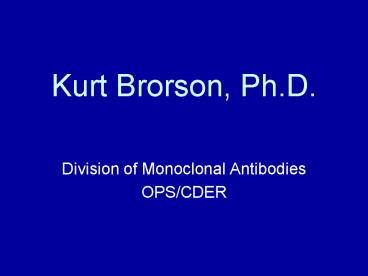Kurt Brorson, Ph.D. - PowerPoint PPT Presentation
1 / 11
Title:
Kurt Brorson, Ph.D.
Description:
Fermentation is an artificial process. vs. plasma or other natural sources ... vs. proteins in cells or bodily fluids. Plasma and recombinant products face ... – PowerPoint PPT presentation
Number of Views:72
Avg rating:3.0/5.0
Title: Kurt Brorson, Ph.D.
1
Kurt Brorson, Ph.D.
- Division of Monoclonal Antibodies
- OPS/CDER
2
Biopharmaceuticals are complex- more potential
heterogeneity than small molecule drugs
3
Heterogeneity in recombinant products and
Monoclonal antibodies
- Cell culture related
- Fermentation is an artificial process
- vs. plasma or other natural sources
- Bioreactor conditions can impact
- Glycosylation
- Some charge variants
- Amino acid substitutions (leu ? norleucine, etc)
- The cell line can impact
- Adduct placement
- Folding/misfolding
- Cysteine pairing
4
Heterogeneity in recombinant products and
Monoclonal antibodies
- Stability related
- Pure, high concentration protein is an artificial
system - vs. proteins in cells or bodily fluids
- Plasma and recombinant products face same
challenges - Clipping
- Aggregation
- Deamidation (Asn ? Asp Gln ? Glu loss of e-NH2
on Lys - Oxidation (Met ? Met sulfoxide)
5
Antibody Heterogeneity- Major role of
glycosylation, C-terminal lys
K
K
6
Expected Heterogeneity-experience with
monoclonal antibodies
C terminal lysine variability occurs in most
monoclonal antibody products Manufacturers set
acceptable ranges for each species Can be
measured by various techniques, wCEX-HPLC, IEF,
others Doesnt seem to impact potency or safety
profile
7
Monoclonal antibodiesUnacceptable, stress
induced heterogeneity
Detectable by various methods Manufacturers set
stability specifications Can compromise potency
if OOS
8
Heterogeneity-experience with other recombinant
products
- Case 1 protein terminus heterogeneity
- Traced to metaloprotease
- Minimal impact on potency
- Case 2 product clipping
- Minimal impact on potency
- Case 3 N-terminal glutamine cyclization
- Cyclized form had increased activity
9
Strategies to maintain product quality
- Testing- lot release stability
- Employ a range of assays
- IEF, wCEX-HPLC- charge variants
- Tryptic peptide mapping, N C-terminal sqxing-
amino acid sequence variants, oxidation, adduct
formation - SDS-PAGE, SEC-HPLC- clipping, aggregate formation
- Mass spectroscopy- molecular weight changes
- Specialized assays- carbohydrate analysis,
IsoQuant, others - Set acceptable ranges for quality attributes
- Based on clinical manufacturing experience
10
Strategies to maintain product quality
- Formulation, purification and storage- minimize
change over time - Formulation
- Lyophilization vs. liquid
- pH control
- Stabilizers (sugars, polyhydric alcohols)
- Surfactants
- N2 overlay in vial
- Product attributes
- Residual enzymes
- Some metals (Cu, etc.)
- Storage
- Correct temperature
- Minimize O2, bubbles in vial
- Protect from light
11
Strategies assessment of impact
- If heterogeneity cant be avoided
- Control it
- Does heterogeneity impact API potency?
- Is it near effector parts of protein?
- Assess via potency assay
- Does heterogeneity impact bioavailability?
- Major glycoform changes
- Assess in PK studies
- Does heterogeneity impact immunogenicity?
- Placement, type, extent of substitutions
- Sometimes assess in immunogenicity studies
- Case dependent






























